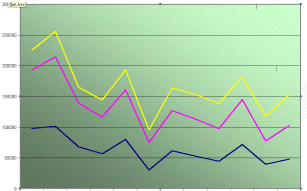Summary of Report.
Situation analysis:
| Hapman Clothing co has been selling clothes for the past 73 years. They have two factories making their product domestically, and they also use contract work from abroad. Their product is retailed at department stores across the country, and they also feature in a number of mail order catalogues. Recently they launched an internet site for customers who want to buy direct. |
| As can be seen from the sales figures for the past 12 months, sales dropped sharply in the first part of the year. There has been some recovery in clothing sales to men and women but sales of children's clothing remain flat. |  |
Market trends.
| Recently the market for their product has expanded, with a greater proportion of the national income being spent on clothing. |  | As can be seen from chart 1A sales in the early part of the decade have been flat, and even fell in the recent recession, but they have since recovered strongly. Though there was a slight dip the year before last, figures have climbed ever since, and there is no sign yet that the market has peaked. |
Outlook.
Strong competition both at home and abroad has forced down the cost of fabrics, and the company's buyers have closed a number of very favourable deals, locking suppliers into long-term contracts on very favourable terms. However, it appears the company's competitors have done the same. This means that the market over the coming two years will be very competitive. Therefore it is important that Hapman clothing find a strong selling point, either in terms of price, style, quality image or some combination of these.
Competition
As you can see from the pie charts, which show Hapman's share of the market as a dark blue wedge, it can be seen that the company's market share today (chart A) is less than it was five years ago (chart B). In short, Hapman's has been losing market share. This is mainly due to the expansion of the market leader Tommy Dee and Ausweiss. The red wedge represents imported clothing from foreign brands, and it can be seen that this sector too is expanding. This means that smaller domestic companies, such as Hapman's are being squeezed.
Risks and opportunities.
The fact that more people are spending more money on their clothes means that Hapman's has a chance to approach new customers in an expanding market. Technological change means that there are new ways to find customers, such as marketing through the internet. Hapman's has good brand recognition, and an established customer base. The challenge for this company is to break out of its present market, and expand into new ones. The risk is clearly shown in the falling sales figures at a time when the market is expanding. New brands such as Ausweiss are expanding aggressively, and their products are seen as very attractive by certain key market segments. The risk is that Hapman's sales might continue to decline to the point where retailers lose interest in stocking their goods, after which the company has a serious risk of failing.
|
1. Who is this report for?
a. a newspaper. 
b. shareholders. 
c. a management consultancy. 
d. company directors. 
2. On the graph which colour represents sales to men and women?
a. yellow and purple. 
b. yellow and green. 
c. purple and green. 
3. What colour represents sales of children's clothes?
a. yellow. 
b. purple. 
c. green. 
4. What can be understood from the information in chart 1A?
a. Hapman clothing is underperforming. 
b. Men are Hapman's best customers. 
c. Clothes are getting more expensive. 
d. Sales are rising. 
5. What is the challenge mentioned in the sector headed 'Outlook'?
a. To keep prices down. 
b. To find cheaper suppliers. 
c. To make the product distinctive. 
d. To compete for two years. 
6. Which pie chart is pie chart A?
a. The one on the left. 
b. The one on the right. 
7. What colour wedge probably represents Tommy Dee clothing?
a. Black. 
b. Cream. 
c. Light blue. 
d. Red. 
8. How would you describe the tone of the risks and opportunities?
a. Critical. 
b. Optimistic. 
c. Pessimistic. 
d. Balanced. 
ANSWERS
|


